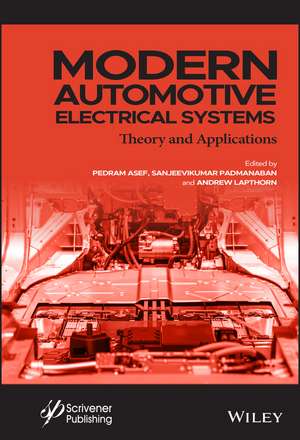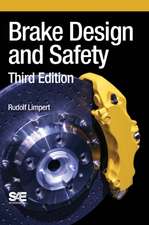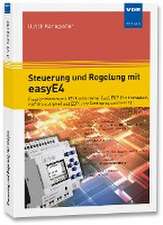Modern Automotive Electrical Systems
Autor P Asefen Limba Engleză Hardback – 8 dec 2022
Preț: 1072.77 lei
Preț vechi: 1178.88 lei
-9% Nou
Puncte Express: 1609
Preț estimativ în valută:
205.31€ • 212.71$ • 171.34£
205.31€ • 212.71$ • 171.34£
Carte tipărită la comandă
Livrare economică 21 martie-04 aprilie
Preluare comenzi: 021 569.72.76
Specificații
ISBN-13: 9781119801047
ISBN-10: 1119801044
Pagini: 256
Dimensiuni: 156 x 235 x 17 mm
Greutate: 0.53 kg
Editura: Wiley
Locul publicării:Hoboken, United States
ISBN-10: 1119801044
Pagini: 256
Dimensiuni: 156 x 235 x 17 mm
Greutate: 0.53 kg
Editura: Wiley
Locul publicării:Hoboken, United States
Cuprins
1 General Introduction and Classification of Electrical Powertrains 1
Johannes J.H. Paulides, Laurentiu Encica, Sebastiaan van der Molen and Bruno Ricardo Marques
1.1 Introduction 1
1.2 Worldwide Background for Change 6
1.3 Influence of Electric Vehicles on Climate Change 12
1.4 Mobility Class Based on Experience in the Netherlands (Based on EU Model) 13
1.5 Type-Approval Procedure 18
1.6 Torque-Speed Characteristic of the Powertrain for Mobility Vehicles 23
1.7 Methods of Field Weakening Without a Clear Definition 31
1.8 Consideration and Literature Concerning "Electronic" Field Weakening: What Does it Mean? 33
1.9 Summary of Electronic Field Weakening Definitions 35
1.10 Critical Study of Field Weakening Definitions 36
1.11 Motor Limits 40
1.12 Concluding Remarks 49
References 51
2 Comparative Analyses of the Response of Core Temperature of a Lithium Ion Battery under Various Drive Cycles 55
Sumukh Surya and Vineeth Patil
2.1 Introduction 56
2.2 Thermal Modeling 62
2.3 Methodology 63
2.4 Simulation Results 65
2.5 Conclusions 71
References 71
3 Classification and Assessment of Energy Storage Systems for Electrified Vehicle Applications: Modelling, Challenges, and Recent Developments 75
Seyed Ehsan Ahmadi and Sina Delpasand
3.1 Introduction 76
3.2 Backgrounds 79
3.2.1 EV Classifications 79
3.2.2 EV Charging/Discharging Strategies 80
3.2.2.1 Uncontrolled Charge and Discharge Strategies 80
3.2.2.2 Controlled Charge and Discharge Strategies 80
3.2.2.3 Wireless Charging of EV 81
3.2.3 Classification of ESSs in EVs 83
3.3 Modeling of ESSs Applied in EVs 84
3.3.1 Mechanical Energy Storages 84
3.3.1.1 Flywheel Energy Storages 84
3.3.2 Electrochemical Energy Storages 84
3.3.2.1 Flow Batteries 85
3.3.2.2 Secondary Batteries 85
3.3.3 Chemical Storage Systems 92
3.3.4 Electrical Energy Storage Systems 94
3.3.4.1 Ultracapacitors 94
3.3.4.2 Superconducting Magnetic 95
3.3.5 Thermal Storage Systems 95
3.3.6 Hybrid Storage Systems 96
3.3.7 Modeling Electrical Behavior 96
3.3.8 Modeling Thermal Behavior 100
3.3.9 SOC Calculation 102
3.4 Characteristics of ESSs 104
3.5 Application of ESSs in EVs 105
3.6 Methodologies of Calculating the SOC 106
3.6.1 Current-Based SOC Calculation Approach 107
3.6.2 Voltage-Based SOC Calculation Approach 108
3.6.3 Extended Kalman-Filter-Based SOC Calculation Approach 110
3.6.4 SOC Calculation Approach Based on the Transient Response Characteristics 113
3.6.5 Fuzzy Logic 115
3.6.6 Neural Networks 116
3.7 Estimation of Battery Power Availability 116
3.7.1 PNGV HPPC Power Availability Estimation Approach 116
3.7.2 Revised PNGV HPPC Power Availability Estimation Approach 117
3.7.3 Power Availability Estimation Based on the Electrical Circuit Equivalent Model 119
3.8 Life Prediction of Battery 121
3.8.1 Aspects of Battery Life 121
3.8.1.1 Temperature 122
3.8.1.2 Depth of Discharge 122
3.8.1.3 Charging/Discharging Rate 123
3.8.2 Battery Life Prediction Approaches 124
3.8.2.1 Physic-Chemical Aging Method 124
3.8.2.2 Event-Oriented Aging Method 124
3.8.2.3 Lifetime Prediction Method Based on SOL 125
3.8.3 RUL Prediction Methods 132
3.8.3.1 Machine Learning Methods 132
3.8.3.2 Adaptive Filter Methods 132
3.8.3.3 Stochastic Process Methods 133
3.9 Recent Trends, Future Extensions, and Challenges of ESSs in EV Implementations 133
3.10 Government Policy Challenges for EVs 137
3.11 Conclusion 138
References 139
4 Thermal Management of the Li-Ion Batteries to Improve the Performance of the Electric Vehicles Applications 149
Hamidreza Behi, Foad H. Gandoman, Danial Karimi, md Sazzad Hosen, Mohammadreza Behi, Joris Jaguemont, Joeri Van Mierlo and Maitane Berecibar
4.1 Introduction 151
4.2 The Objective of the Research 153
4.3 Electric Vehicles Trend 153
4.4 Thermal Management of the Li-Ion Batteries 154
4.4.1 Internal Battery Thermal Management System 154
4.4.2 External Battery Thermal Management System 155
4.4.2.1 Active Cooling Systems 155
4.4.2.2 Passive Cooling Systems 163
4.5 Lifetime Performance of Li-Ion Batteries 170
4.5.1 Why Do Batteries Age? 171
4.5.2 Characterisation Techniques of Aging 171
4.5.3 Lifetime Tests Protocols of the Li-Ion Batteries 172
4.5.4 Lifetime Results of Different Li-Ion Technologies 174
4.6 Basic Aspects of Safety and Reliability Evaluation of EVs 175
4.6.1 Concept Reliability Analysis of Battery Pack from Thermal Aspects 176
4.6.2 Reliability Assessment of the Li-Ion Battery at High and Low Temperatures 177
4.7 Conclusion 179
References 180
5 Fault Detection and Isolation in Electric Vehicle Powertrain 193
Gbanaibolou Jombo and Yu Zhang
5.1 Introduction 194
5.1.1 EV Powertrain Configurations 194
5.1.1.1 Battery Electric Vehicle (BEV) 196
5.1.1.2 Hybrid Electric Vehicle (HEV) 197
5.1.1.3 Fuel Cell Electric Vehicle (FCEV) 199
5.1.2 EV Powertrain Technologies 199
5.1.2.1 Energy Storage System 199
5.1.2.2 Electric Motor 201
5.1.2.3 Power Electronics 202
5.2 Battery Fault Diagnosis 203
5.2.1 Battery Management System (BMS) 203
5.2.2 Model-Based FDI Approach 206
5.2.2.1 Battery Modelling 206
5.2.3 Signal Processing-Based FDI Approach 211
5.2.3.1 State of Charge (SOC) Estimation 212
5.2.3.2 State of Health Estimation 213
5.3 Electric Motor Fault Diagnosis 213
5.3.1 Electric Motor Faults 213
5.3.1.1 Mechanical Fault 213
5.3.1.2 Electrical Fault 213
5.3.2 Signal Processing-Based FDI Approach 214
5.3.2.1 Motor Current Signature Analysis (MSCA) 214
5.4 Power Electronics Fault Diagnosis 218
5.4.1 Signal Processing-Based FDI Approach 219
5.4.1.1 Open Switch Fault 219
5.4.1.2 Short Switch Fault 221
5.5 Conclusions 222
References 222
Index 227



















